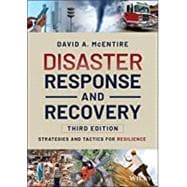The new edition of the standard textbook in the field, updated with new studies and practical guidelines for reacting to the complexities of today’s disasters
Disaster Response and Recovery: Strategies and Tactics for Resilience provides a thorough overview of the challenges and functions of the emergency management profession, covering the various types of disasters, theoretical frameworks, the different individuals and agencies involved, technological tools, practical response measures, and more. Written by a recognized leader in the field, this comprehensive textbook offers clear guidance on developing disaster resilience through preparedness, planning, improvisation, leadership, and professionalism.
Revised and updated throughout, the third edition addresses key response and recovery operations of the COVID-19 pandemic, including human attitudes, political issues, communication challenges, medical surges, and volunteer management. New examples and case studies also highlight lessons learned from Hurricane Irma, the California wildfires, brush fires in Australia, the Midwest derecho windstorm, the Beirut explosion, the Las Vegas shooting, riots and civil unrest in the United States, and other recent disasters. In addition, the book:
- Describes tools and techniques required to protect lives, reduce property damage, and minimize disruption
- Features new coverage of climate change, social media, drones and artificial intelligence, racial and social justice, recent legislation and regulations, and emergency management policies and procedures
- Discusses theoretical approaches to the management of disasters, strategies to revitalize affected communities, and mitigation methods to reduce future vulnerability
- Contains learning objectives, key term definitions, case studies, real-world examples, summary and review questions, and evaluation tools
- Includes access to a companion website with an instructor’s manual, a sample syllabus, chapter tests, PowerPoint slides, exam questions, and additional teaching resources
Integrating the theory and practice of emergency management, public administration, policy, and sociology, Disaster Response and Recovery: Strategies and Tactics for Resilience, Third Edition is an invaluable resource for advanced students in emergency management programs as??well as emergency planners, emergency management coordinators, risk managers, and other practitioners in the field.








